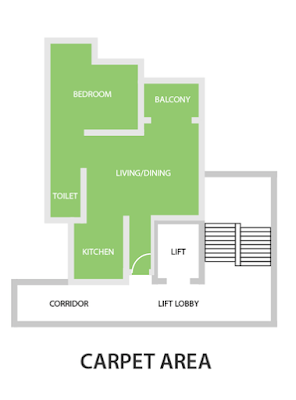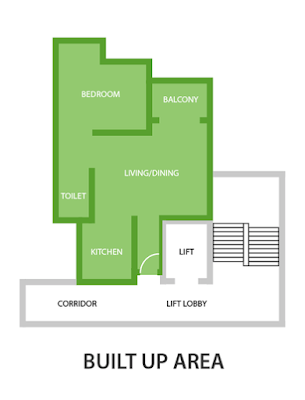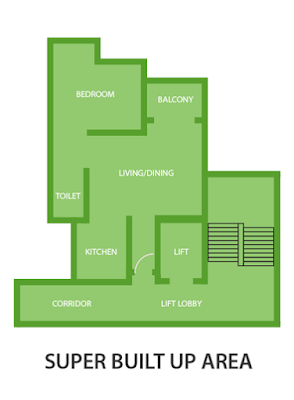A carpet area refers as the net useable space.
It is defined as the space surrounded by the outer walls and the actual area where the carpets can be laid.
In this article you’ll learn:
- What is Carpet Area in the flat?
- Purpose of Carpet Area.
- Built-up Area & Super Built-up Area.
- Carpet Area Calculations.
- Lots more.
So, if you’re ready to go with it, this article is for you.
Let’s dive right in.
What is the Carpet Area?
The carpet area is the total floor space of all useable rooms on any given level i.e. Carpet area = Area of bedroom + living room + balconies + toilets + thickness of the inner walls.
In most circumstances, the flat’s carpet area will be 70% of its total built-up space. As a result, a property’s built-in area is 1,500 square feet will have a floor size of roughly 1,050 square feet.
Purpose of Carpet Area:
- The developers are now obliged to reveal the carpet area of the flats they offer.
- This enables homebuyers to know the actual dimensions of the unit, as well as which parts of the land, are included.
- Customers now get an exact estimation of the useable area because of the precise definition of carpet area.
Carpet Area as per RERA:
According to Real Estate Regulatory Authority (RERA) is a dwelling’s net useable floor space.
This is the entire floor area of your property, excluding walls, terraces, balconies or veranda space outside the walls surrounding the usable area of your property.
But the internal partitions of the flat with the surface are covered in carpet area.
The phrase “exclusive balcony or veranda space” includes the area of a fully employed and operated by the private sector balcony or veranda for the net useable floor area of the property.

Carpet Area Calculation Formula:
Carpet Area = Sum of all (Bedroom Area + Living Room Space + Balconies + Toilets) – Inner Wall Thickness.
Difference between RERA Carpet Area and Net Usable Carpet Area:
In RERA, the carpet zone is characterized as the unit’s net useable space, which contains the size of the inside walls.
On the other hand, the general carpetarea differs in only one element that removes the area of the inner walls.
Is it possible to change the carpet area?
Prior to the implementation of RERA, it was easy for the developer to adjust the floor area of the flat as needed.
But now it is not so easy!
Section 14 of the RERA Act states that any developer may modify the layout plan, approved plan, and accommodation requirements with the prior permission of the person who is committed to accepting parts or all units.
Therefore, it is up to the person to decide whether or not the builder can modify his residential decision.
Punishment for illegally modifying the RERA Carpet Area:
The RERA Act imposes severe penalties on builders who violate the rules.
Pursuant to Section 61 of the Act, any organizer who violates any other provisions provided in Section 3 or 4 of this Act or violates the rules and regulations made under the sections, shall be liable to a penalty of up to 5%.
The estimated cost of the property development project is calculated by the Authority.
Note:
- If you purchase a project under construction and there is a discrepancy between the floor area specified and the floor area provided upon completion of the apartment, you will be refunded.
- The carpet area can be raised significantly, resulting in a commensurate expense.
- But the increase cannot exceed 3% of the allowable carpetarea.
- RERA establishes these restrictions.
What is Built-up Area?
The built-up space includes the overall carpet surface as well as the extra personal areas covered by the flat’s side walls.
Balconies, patios, mezzanine stories, and service areas are included in the built-up area.
This section takes up 10-15% more space than the carpet areas.
You should also note that the walls belonging to other dwellings are included in 50%, while the other walls are fully measured.
As a result, the formula for determining the built-up area is:
The Built-up Area calculation formula:
Built-up Area = Carpet Area + Area of Walls + Area of the Balcony.

What is Super Built-up Area?
The super built-up area of the premises is for sale.
It includes carpet areas as well as a courtyard, balcony, wall-covered area, and the area occupied by prevalent construction (e.g., elevator, stairs, etc.).
Builders may include facilities such as pools, gyms, and lawns in certain situations.
The load factor on the carpetarea is used by builders to compute the super built-up area.
The Real Estate Regulatory Authority (RERA) defines a super built-up area as the carpet area, built-up space, and portion of the zone such as the staircase and lobbies that may be accessible by the whole structure.
Super Built-up Area as per RERA:
Under the RERA Act, the builder is obliged to inform buyers about the carpetarea and offer rates based on them, rather than the super built-up area.
Buyers can enquire about the carpetarea to super built-up area ratio with the developer.
The carpet area to super built-up area ratio is used to evaluate the accommodation.
A cheap price may not always indicate a good deal.
Prior to RERA, it was common to estimate housing prices based on super-built-up areas, but now not anymore.
The Super built-up area calculation formula:
Super Built-Up Area (Stairs, Lobby, Elevator, Pool, etc.) = Built-up Area + Common Area.

Super Built-up Area- when the common area is known:
To estimate the super built-up area, first, determine the entire area occupied by the common area.
Here are illustrative steps of how to achieve this:
- Suppose there are ten apartments on one level with a total common space of 2800 square feet.
- The overall common area divided by the total number of flats equals the area per unit.
- So, 2800 square feet divided by ten flats, each dwelling is 280 square feet.
Consider the following residences on a floor: 800 sq ft., 1000 sq ft., and 1200 sq ft.
If the common courtyard and lobby space are 1200 sq ft, the super built-up area of the 1200 sq ft apartment is 1,200 sq ft + 480 sq ft (1,680 sq ft).
Whereas the smallest one is 800 sq ft + 320 sq ft (1120 sq. Ft).
Super Built-up Area- when the common area is unknown:
If you don’t know the measurement of the common space, there is another approach to compute the super built-up area.
First, you must know what the loading factor includes.
The super built-up area is calculated by multiplying the loading factor by the carpetarea, hence the formula is:
Carpet area (1+loading factor) = Super built-up area
You may obtain the loading factor % from the providers ranging from 15% to 50%, depending on the developer and the location of the investment.
The loading factor in Bangalore is roughly 25-30%, however, it is substantially greater in Maharashtra.
Super built-up Area vs Carpet Area:
The carpetarea is the precise usable space of the unit you are purchasing, while the super built-up area is the sum of the leased and built-up areas of the property.
Understand the inclusion and exclusion of areas.
Carpet Area vs Built-up Area:
The carpetarea is the surface where the carpet may occupy, whereas the built-up area arises from merging the carpet areas with the perimeter.
Loading Factor:
A property’s loading is the ratio of its super built-up area to its carpetarea.
The cost of the project’s infrastructure is ultimately recoverable by the developers, lifts, lobbies, maintenance room, parking, and patio are just a few examples.
The basic formula for calculating the locality’s loading factor is:
Super built-up = Carpet (1-loading factor)
In ideal circumstances, it should be less than 30% for housing.
Anything on it indicates that the carpet area is small and the super built-up area is large.
This means there will be less space in the buyer’s home.
| Ideal Loading factor (%) | City |
| 40-50 | Mumbai Metropolitan Region (MMR) |
| 30-40 | Delhi-NCR |
| 20-30 | Bangalore |
| 25-30 | Chennai |
Difference between Carpet Area and Built-up Area and Super Built-up Area:
The built-up area, carpetarea, and associated common areas are all part of the super built-up area.
The built-up area includes carpeted sections as well as an open terrace, veranda, and balcony area, as well as areas below the service shaft.
The carpet area is the house’s net useable space includes parts of the inside walls.
| Carpet Area | Built-up Area | Super built-up Area | |
| Living room/Hall | Yes | Yes | Yes |
| Bedroom | Yes | Yes | Yes |
| Dining room | Yes | Yes | Yes |
| Kitchen | Yes | Yes | Yes |
| Bathroom | Yes | Yes | Yes |
| Puja room | Yes | Yes | Yes |
| Study room | Yes | Yes | Yes |
| Balcony | No | Yes | Yes |
| Utility room | No | Yes | Yes |
| Staircase(inside) | Yes | Yes | Yes |
| Staircase(outside) | No | Yes | Yes |
| Terrace | No | Yes | Yes |
| Veranda | No | Yes | Yes |
| Lift | No | No | Yes |
| Lobby | No | No | Yes |
| Garden | No | No | Yes |
| Swimming pool | No | No | Yes |
Frequently Asked Questions:
The carpet area generally includes a balcony.
This is favourable because it will not be taxed, however, you should consider converting it into a carpeted space with the approval of the homeowners’ association and other governing bodies.
If you want to maximize space utilization, you can combine balcony space with the room to which it is related that increasing the carpet space in the room.
Using 1.25 as the loading factor, for illustration, increases the carpetarea of the flat by 25%.
It excludes sections covered by exterior walls, regions below service tunnels, exclusive rooftop or terrace amenities, and exclusive open terraces area.
Also read: Principles of Planning, Components of Building & Town Planning
Conclusion:
When you want to buy a property, real estate brokers or builders can use silly expressions that can be confusing.
If you want to avoid fraud, you need to understand the carpet area, built-up area and super built-up area and their methods of calculation.
We hope this information also helps you save funds.


Related Posts
Refresh Your Office: Simple Ideas to Boost Productivity and Motivation in Your Workplace:
Understanding the Nuances of Office Chair Vs Ergonomic Chair to Select Better!
Rock Quality Designation(RQD): Building Strong Foundations
Spread Footing
Masonry Cement
Plain Cement Concrete
Concrete Efflorescence
Concrete Pile
Stepped Footing